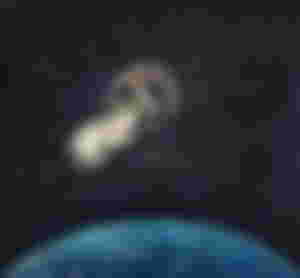Ilustracija u znak sećanja na Lajku, Renia Metallinou
Lajka nije bila sasvim običan pas. Bilo je to malo stvorenje teško svega šest kilograma, mešanka haskija i terijera sa moskovskih ulica, navikla na hladnoću i ekstremne uslove. Ujedno prvi živi sisar poslat u Zemljinu orbitu i prva orbitalna žrtva. Kada je lansirana u svemir znalo se unapred da se Lajka neće vratiti i da će njeno pseće srce zauvek ostati da kuca negde gore, među zvezdama. Još jedan primer ljudske bezosećajnosti. Iako Lajka nije preživela, misija „Sputnjika 2“ je pokazala da živi stvor može da izdrži lansiranje u orbitu i bestežinsko stanje. I još jednom pokazala da je nauka važnija od života jednog bića. Naravno, njena žrtva sa te strane nije bila uzaludna. Stradala je za "dobrobit čovečanstva" omogućila Belki i Strelki, opet psi, da se iz orbite vrate žive i zdrave i utrla put Gagarinu, Leonovu, Titovu, Armstrongu, Oldrinu i nizu kosmonauta koji su se kasnije našli na Međunarodnim svemirskim stanicama.

Laika was a Soviet space dog who became one of the first animals in space, and the first animal to orbit the Earth. Laika, a stray mongrel from the streets of Moscow, was selected to be the occupant of the Soviet spacecraft Sputnik 2 that was launched into outer space on 3 November 1957.Little was known about the impact of spaceflight on living creatures at the time of Laika's mission, and the technology to de-orbit had not yet been developed, so Laika's survival was never expected. Some scientists believed humans would be unable to survive the launch or the conditions of outer space, so engineers viewed flights by animals as a necessary precursor to human missions.The experiment aimed to prove that a living passenger could survive being launched into orbit and endure a micro-g environment, paving the way for human spaceflight and providing scientists with some of the first data on how living organisms react to spaceflight environments.
Laika died within hours from overheating, possibly caused by a failure of the central R-7 sustainer to separate from the payload. The true cause and time of her death were not made public until 2002; instead, it was widely reported that she died when her oxygen ran out on day six or, as the Soviet government initially claimed, she was euthanised prior to oxygen depletion.
On 11 April 2008, Russian officials unveiled a monument to Laika. A small monument in her honour was built near the military research facility in Moscow that prepared Laika's flight to space. It portrayed a dog standing on top of a rocket. She also appears on the Monument to the Conquerors of Space in Moscow.

The Sad, sad story of Laika, the Space Dog, and Her One-Way Trip into Orbit a stray Moscow pup traveled into orbit in 1957 with one meal and only a seven-day oxygen supply. Sad as this tale is, the stray husky-spitz mix became a part of history as the first living creature to orbit the Earth.